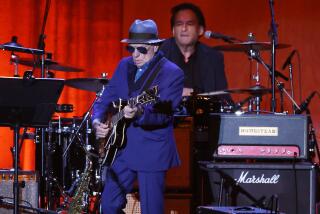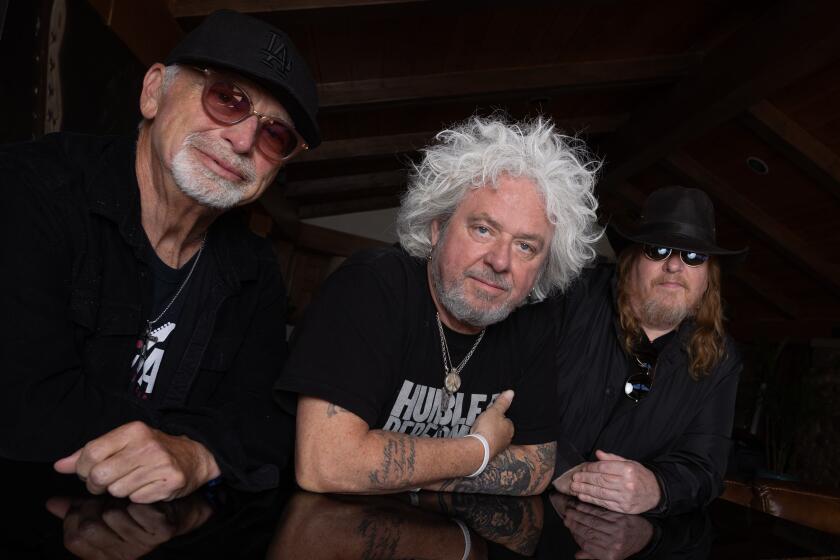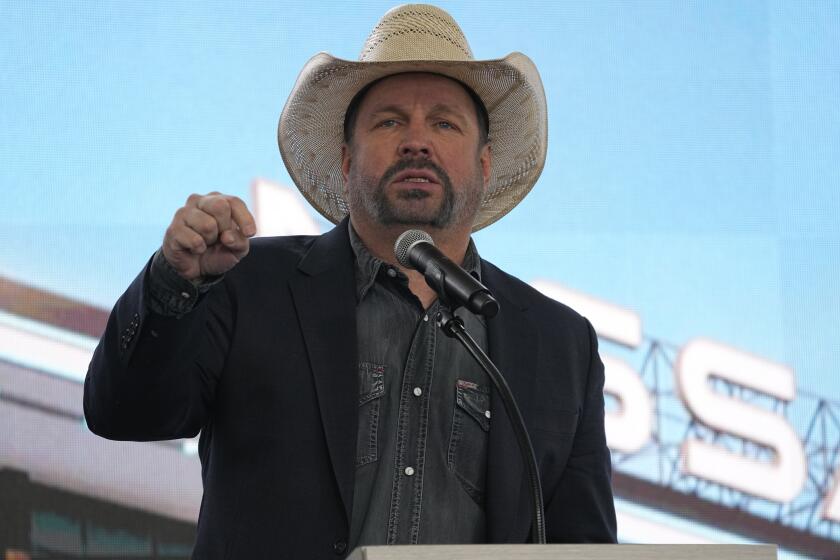Still dreaming
Santa Barbara — Whenever posthumous awards are given at all-star gatherings, someone invariably mentions how surprised the artist would have been that people still felt so strongly about their music after all these years.
But it’s hard to picture anyone saying that about the late Gram Parsons. Even when playing around town to half-empty houses in the late ‘60s, this visionary singer-songwriter was convinced he was making music for the ages.
And, sure enough, more than three decades after his drug-related death at age 26, Parsons’ radical mix of country music innocence and rock ‘n’ roll rebellion still radiates with honesty and heart.
Despite the personal demons that destroyed him, there was an angelic quality about Parsons’ voice that was as seductive as his smile as he sang about dreams -- glorious dreams, lost dreams, shattered dreams -- with such wistful yearning and lonesome anxiety that he seemed at times like F. Scott Fitzgerald with a guitar.
At a warm, enchanting concert Friday at the Santa Barbara Bowl to salute Parsons’ legacy (and repeated the next night at Universal Amphitheatre), nothing reflected the range of his music so much as tender performances by artists whose images place them at opposite ends of the pop spectrum: Norah Jones and Keith Richards.
Jones, whose taste and restraint have made her one of pop’s most welcome arrivals, sang three ballads, ending with “She,” a haunting 1971 tune that is about both Parsons’ Southern heritage and the cleansing power of music.
As Jones sang with the eloquence and grace that Parsons and co-writer Chris Ethridge put into the song, James Burton, the Rock and Roll Hall of Fame guitarist who played on many Parsons recordings, added touches that were equally sensitive and alluring.
In fact, the evening’s band, which also included Parsons studio sidekick Al Perkins on steel guitar, played throughout with dedication and style that sometimes spoke to the heart of Parsons’ musical spirit better than the singers they were backing.
Jones was a hard act to follow, especially for someone like the Rolling Stone co-founder, who may be one of the most beloved guitarists in rock but whose scratchy voice has severe limitations.
Yet Richards, playing acoustic guitar, earned a standing ovation as he teamed with Jones vocally to convey the ache of “Love Hurts,” a Boudleaux Bryant tune that Parsons recorded.
Parsons and Richards were great friends back in the days when Parsons was virtually unknown and Richards was already a rock legend.
Richards was enamored of the country music that Parsons played for him -- and that influence contributed to the country side of the Stones, including such numbers as “Wild Horses.”
Because he probably knew Parsons better than anyone else on the bill, Richards seemed to feel an obligation to say a few words about his late friend.
But the guitarist fidgeted nervously, before finally turning to a joke.
“If the good die young, where does that leave me?” he asked, laughing.
Finally, Richards realized the best way to express his affection was to simply sing another song.
“This is the first song Gram played for me,” he said, before launching into “Hickory Wind,” which speaks so beautifully about a restless soul longing for the comfort of childhood roots.
The moment was all the more evocative because a giant photo of a young Parsons and Richards was shown on a screen behind him as he sang the Parsons-Bob Buchanan song.
It’s a hard way to find out
That trouble is real
In a far away city, with a far away feel
But it makes me feel better
Each time it begins
Callin’ me home, hickory wind.
There wasn’t much to say after that, and the remaining numbers -- including an ensemble version of “Wild Horses” -- felt a bit anticlimactic.
Earlier, however, several moments were as soulful and sweet as Parsons’ own recordings.
Several of the musicians even wore the rhinestone cowboy suits that Parsons used to add to the culture shock of his shows.
In the ‘60s and early ‘70s, the suits symbolized everything young rock fans found corny about country music. To unnerve the conservative country fans, Parsons had the outlines of marijuana plants woven into the suit’s designs.
In the opening half of the program, alt-country veteran Jay Farrar captured the radical side of Parsons with a wonderfully rowdy rendition of “Drug Store Truck Drivin’ Man,” a zesty story of cultural stereotypes that Parsons wrote with Roger McGuinn during his brief stay with the Byrds before forming the Flying Burrito Brothers with Chris Hillman.
The Mavericks’ Raul Malo, who is blessed with one of the most dramatic voices in pop, nailed the barroom melancholy of “Close Up the Honky Tonks.”
In the second half, Steve Earle and Lucinda Williams delivered stirring sets.
Earle showcased the biting, anti-draft commentary of “My Uncle,” while Williams turned to two heartache ballads as dark and affecting as the ones she writes.
Not everything, however, worked.
The low point was Dwight Yoakam’s attempt to transform one of Parsons’ signature tunes, “Sin City,” into even more of an apocalyptic statement.
Written with Hillman, the song summarizes the struggle between innocence and temptation that ran through Parsons’ music, a number that seems in many ways a forerunner of the Eagles’ “Hotel California.”
In turning the poignant number into a demolition derby, Yoakam shattered the soulf- ul nuances of the song, making it at times almost unrecognizable.
The cast, which also included John Doe, Jim Lauderdale, Kathleen Edwards and Jim James, seemed even more energized Saturday, but the high and low points remained the same.
The event, whose organizers included Parsons’ daughter, Polly, was designed to both celebrate his memory and raise funds for the Musicians’ Assistance Program.
Over the two nights, various performers mentioned how much they had been influenced musically by Parsons, but Earle pointed out backstage how Parsons’ attempt to meld country and rock cultures was inspiring on an even wider level.
“He made me feel not so weird, that it was OK to have long hair and wear cowboy boots, to listen to country music and rock ‘n’ roll,” he said.
“I mean those weren’t just separate types of music, but the people who liked them were in separate camps back then. Gram saw the humanity in both and brought us a lot closer together.”
*
Robert Hilburn can be reached at Robert.hilburn@latimes.com
More to Read
The biggest entertainment stories
Get our big stories about Hollywood, film, television, music, arts, culture and more right in your inbox as soon as they publish.
You may occasionally receive promotional content from the Los Angeles Times.










